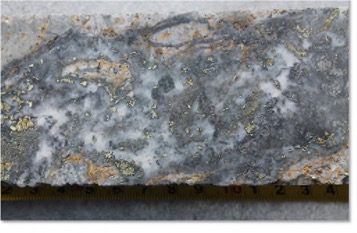Thomson Resources (ASX: TMZ) has identified visual indications of base metal mineralisation on the margins of the Strauss-Kylo open pits at the Mt Carrington gold-silver-base metal project in NSW, Australia.
The new assessment follows relogging and drill hole core cutting of the geotechnical holes drilled by the company in 2021.
This provides additional evidence that the mineralisation extends beyond the boundaries of the previously reported optimised ‘gold only’ pit shells, reinforcing the potential to extend the gold equivalent resource (gold + base metal), which will lead to larger open pits and hence lower mining costs and potentially improved financial metrics. It will also add to the resources available to Thomson’s New England Fold Belt Hub and Spoke Strategy (NEFBHS).
“We had put these holes, which were not exploration holes, to one side as we set about renegotiating the terms of our earn-in and option to JV agreement with White Rock. With that done and the freeing up of our resources we came back and had a look at them to see what we could see,” Executive Chairman David Williams, said.
“As we noted in our ASX Release on 22 June 2022 on our updated polymetallic MRE’s for the Strauss and Kylo deposits, we believed it was likely that the polymetallic mineralisation extended beyond those constrained pit shells.
“To have that view reinforced by holes not drilled for that purpose demonstrates our shift in approach with Mt Carrington to focus on the potential coalescing of the deposits into a large polymetallic resource, is the correct one.”
Seven diamond drill holes (GT001-7) were drilled by Thomson in 2021 as part of the work for a DFS on the Mt Carrington Gold First Project which was part of the earn-in obligations under the Earn-in and Joint Venture Agreement with White Rock Minerals Ltd.
In that initial agreement Thomson had the option to earn 70% of the total Mt Carrington project by funding the advancement of the Strauss and Kylo gold and silver project, including the completion of a DFS and the submission of an Environmental Impact Statement (EIS).
Three of the short diamond holes were drilled on the margins of the optimised Kylo open pit, two were drilled on the margin of the Strauss open pit and two were drilled at Kylo West.
Samples of core from each hole were to be sent for geotechnical compression and shear tests to assist with pit stability studies, but these tests were not completed due to the parties deciding to renegotiate the earn-in terms of the Earn-in and Joint Venture Agreement, which restructured agreement was executed by the parties in May 20222. Thomson’s focus then shifted to an assessment of the larger scale silver-gold polymetallic opportunity that was anticipated to result in larger open pits.
Broad zones of alteration with quartz veining containing zinc sulphide (sphalerite), lead sulphide (galena) and copper sulphide (chalcopyrite) were logged in several of the holes including GT002 in the Kylo pit and GT005 in the Strauss pit.
The mineralised intervals have been cut and sampled and will be submitted to the laboratory for gold and base metal analysis. No assay results are currently available.
The Mt Carrington gold-silver-base metal project is located 5km from the township of Drake in northern NSW on the Bruxner Highway. The Project is located one hour from the regional centres of Casino and Tenterfield in NSW and importantly located within potential trucking distance of Thomson’s 100% owned Texas District, Conrad and Webbs silver base metal projects.
For further information please visit: https://www.thomsonresources.com.au/












